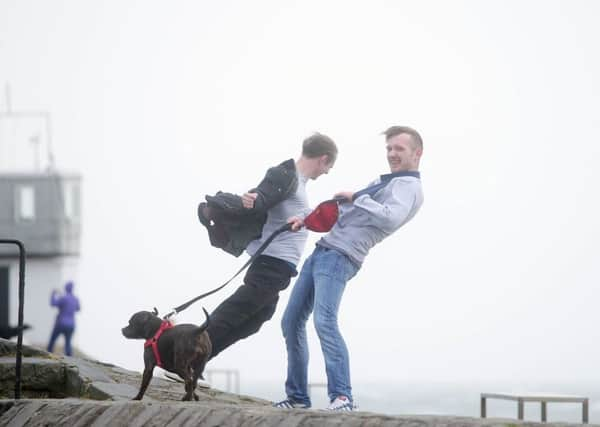NI storm shutdown: how do other cities handle big weather events?


The News Letter has sought a picture of how developed cities elsewhere in the world react to severe weather, after the response of Northern Irish authorities to the looming arrival of the remnants of Hurricane Ophelia on Monday came in for criticism.
Schools closed for two days, rail and bus routes were cancelled, and Belfast businesses and attractions shut up shop – leaving tourists wandering in bemusement around a virtually-deserted city centre.
Advertisement
Hide AdAdvertisement
Hide AdIn the event, the highest single gust was 71mph at an isolated coastal spot, and the great bulk of the Province saw top wind speeds which were considerably lower.
The News Letter asked authorities in storm-prone cities in the USA, plus ultra-northerly Finnish capital Helsinki, how they cope with extreme weather, and if the prediction of a storm with maximum gusts of 80mph would have led to a similar shutdown there.
KANSAS:
In Kansas City – right in the heart of so-called “tornado alley” in America’s land-locked and largely-flat mid-west – emergency management co-ordinator Jennifer Fales said: “Severe thunderstorms with gusty winds are not uncommon for us and we usually have little warning when a thunderstorm turns severe.
“That being said, it has not been my experience that services shut down for such an event, but we do try to encourage our residents to be aware of potentially-threatening conditions and provide warnings to seek shelter when appropriate, particularly for tornado warnings.”
OKLAHOMA:
Advertisement
Hide AdAdvertisement
Hide AdFurther south in the city of Oklahoma, police lieutenant Franklin Barnes, the city’s emergency manager, said he was “not going to second guess the actions of your elected and appointed officials because I wasn’t there”.
He also added that whether it is the USA or Ireland, decisions about preparing for storms “are made based upon what is known at the time and not what is known later”.
“You plan and prepare for the worst and then if nothing happens you’re thankful,” he said.
Whilst his city does not experience hurricanes, it does have tornadoes, thunderstorms and “damaging winds” to contend with.
Advertisement
Hide AdAdvertisement
Hide AdWhen a severe thunderstorm is forecast, TV coverage will be “wall-to-wall”.
“As the storms pass over people will take shelter inside a building until the threat passes by. Other than a temporary disruption or inconvenience life goes on,” he said.
If a “high-end tornado event” is forecast, people may leave work or school early, some businesses may close, and events may be cancelled.
However “government services including mass transit will continue to operate and only take protective actions when there is a tornado warning (a tornado is occurring)”.
Advertisement
Hide AdAdvertisement
Hide AdWhilst ice storms and blizzards can cause closures of schools, businesses, transport systems, and a reduction in government service, “the City of [Oklahoma] almost never closes city offices nor reduces services for winter weather”.
Though the maximum wind speed in Northern Ireland forecast by the Met Office during the storm had been 80mph, the agency had said that more general gusts could be around 55mph to 60mph.
Lt Barnes said if Oklahoma got a forecast like that, “no services would be suspended/stopped and nothing would close” (though “some outdoor events might be cancelled by event organisers”).
He added: “The musical “Oklahoma” has a song with lyrics about the wind in Oklahoma. Those lyrics are not made up – the wind blows here often.”
FLORIDA:
Advertisement
Hide AdAdvertisement
Hide AdIn Key West, an island town on the far southern tip of Florida – on the shore of the hurricane-prone Gulf of Mexico – city manager Jim Scholl said they lacked high ground or safe shelters in the event of major storms, and that flooding is a serious threat.
“Any time the winds are sustained above 35 to 40 miles per hour, some or all of the schools will be closed due to school buses and safe driving concerns,” he said.
“We have 42 bridges where high profile vehicles can be a danger. Business are usually closed during evacuations as the employees are gone.”
Asked directly if the prediction of 80mph gusts would have caused his region to react the way Northern Ireland did. he said: “Absolutely!”
FINLAND:
Advertisement
Hide AdAdvertisement
Hide AdHelsinki, the second most northerly capital city of a sovereign nation in the world, is largely characterised by a different type of weather – deep cold.
However, Heikki Mantymaki of the city’s planning department said “a pretty hard thunderstorm” in the city last August, with gusts up to about 67mph, cut down at least 10,000 trees, took roofs off buildings, and hit transport and electricity – “but basically all major functions in our society worked pretty well”.
There was no mass closure of businesses, and a pop festival which was happening at the time experienced only a handful of cancelled performances.
He said “even if there is heavy snowing our city works well, major roads are kept in ok condition, buses are running as well as our metro and people are able to drive their cars... snowing does not stop Finland or Helsinki”.